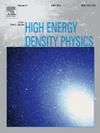Evaluation of circular geodesics and thermodynamics of a Bumblebee gravity-like black hole
IF 0.9
3区 物理与天体物理
Q3 PHYSICS, FLUIDS & PLASMAS
引用次数: 0
Abstract
In this study, we explore the thermodynamic and geodesic stability of Reissner–Nordström (RN) black holes within the framework of Bumblebee gravity (BG), a Lorentz-violating extension of general relativity (GR). By examining the black hole’s mass distribution and horizon thermodynamics, we establish that although charged black holes in BG exhibit local stability, they remain globally unstable. This conclusion is substantiated by the positive-definite Gibbs free energy and the negative-definite Hessian matrix, which collectively indicate a fundamental instability in the system’s global equilibrium. We utilized the effective potential to derive the Lyapunov exponents for both time-like and null geodesics, assessing their stability. We found that the circular orbits beyond the innermost stable circular orbits in the Schwarzschild regime are stable, which contrasts with the RN black hole solution in GR. Furthermore, our findings demonstrate that a strong Bumblebee field induces unstable orbits. We establish that extreme RN black holes in Einstein gravity do not possess quasi-normal frequencies and instead exhibit stable, constant perturbations. In the non-extremal case, perturbations settle into a steady state, maintaining a constant amplitude. This behavior parallels observations made in the context of the Bumblebee effect.
大黄蜂引力黑洞的圆测地线和热力学评价
在这项研究中,我们探索了在大黄蜂引力(BG)框架下Reissner-Nordström (RN)黑洞的热力学和测地线稳定性,大黄蜂引力是广义相对论(GR)的一个违反洛伦兹的扩展。通过检查黑洞的质量分布和视界热力学,我们确定尽管BG中的带电黑洞表现出局部稳定性,但它们仍然是全局不稳定的。正定的吉布斯自由能和负定的黑森矩阵证实了这一结论,它们共同表明系统的全局平衡存在根本的不稳定性。我们利用有效势导出了类时测地线和零测地线的Lyapunov指数,并评估了它们的稳定性。我们发现,在史瓦西政权中,最内层稳定的圆轨道之外的圆轨道是稳定的,这与GR中的RN黑洞解形成了对比。此外,我们的发现表明,强大黄蜂场诱导了不稳定的轨道。我们建立了爱因斯坦引力下的极端RN黑洞不具有准正态频率,而是表现出稳定的、恒定的扰动。在非极值情况下,扰动进入稳定状态,保持恒定的振幅。这种行为与在大黄蜂效应背景下的观察结果相似。
本文章由计算机程序翻译,如有差异,请以英文原文为准。
求助全文
约1分钟内获得全文
求助全文
来源期刊

High Energy Density Physics
PHYSICS, FLUIDS & PLASMAS-
CiteScore
4.20
自引率
6.20%
发文量
13
审稿时长
6-12 weeks
期刊介绍:
High Energy Density Physics is an international journal covering original experimental and related theoretical work studying the physics of matter and radiation under extreme conditions. ''High energy density'' is understood to be an energy density exceeding about 1011 J/m3. The editors and the publisher are committed to provide this fast-growing community with a dedicated high quality channel to distribute their original findings.
Papers suitable for publication in this journal cover topics in both the warm and hot dense matter regimes, such as laboratory studies relevant to non-LTE kinetics at extreme conditions, planetary interiors, astrophysical phenomena, inertial fusion and includes studies of, for example, material properties and both stable and unstable hydrodynamics. Developments in associated theoretical areas, for example the modelling of strongly coupled, partially degenerate and relativistic plasmas, are also covered.
 求助内容:
求助内容: 应助结果提醒方式:
应助结果提醒方式:


